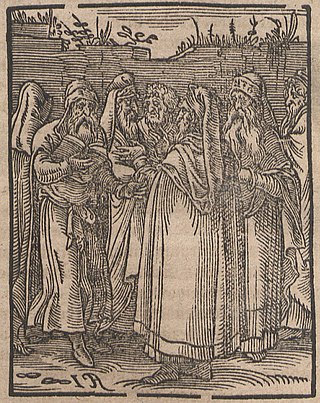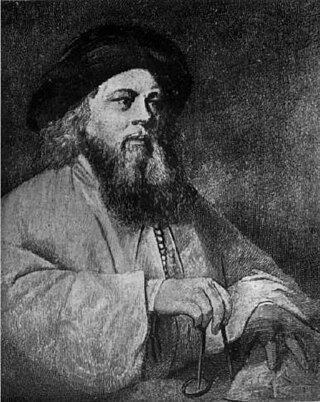
Abraham Joshua Heschel was a Polish-American rabbi and one of the leading Jewish theologians and Jewish philosophers of the 20th century. Heschel, a professor of Jewish mysticism at the Jewish Theological Seminary of America, authored a number of widely read books on Jewish philosophy and was a leader in the civil rights movement.

Kabbalah or Qabalah is an esoteric method, discipline and school of thought in Jewish mysticism. A traditional Kabbalist is called a Mekubbal. The definition of Kabbalah varies according to the tradition and aims of those following it, from its origin in medieval Judaism to its later adaptations in Western esotericism. Jewish Kabbalah is a set of esoteric teachings meant to explain the relationship between the unchanging, eternal God—the mysterious Ein Sof —and the mortal, finite universe. It forms the foundation of mystical religious interpretations within Judaism.

The Tanya is an early work of Hasidic philosophy, by Rabbi Shneur Zalman of Liadi, the founder of Chabad Hasidism, first published in 1796. Its formal title is Likkutei Amarim, but is more commonly known by its first Hebrew word tanya, which means "it has been taught", where he refers to a baraita section in "Niddah", at the end of chapter 3, 30b. Tanya is composed of five sections that define Hasidic mystical psychology and theology as a handbook for daily spiritual life in Jewish observance.
Academic study of Jewish mysticism, especially since Gershom Scholem's Major Trends in Jewish Mysticism (1941), draws distinctions between different forms of mysticism which were practiced in different eras of Jewish history. Of these, Kabbalah, which emerged in 12th-century southwestern Europe, is the most well known, but it is not the only typological form, nor was it the first form which emerged. Among the previous forms were Merkabah mysticism, and Ashkenazi Hasidim around the time of the emergence of Kabbalah.
Gilgul is a concept of reincarnation or "transmigration of souls" in Kabbalistic esoteric mysticism. In Hebrew, the word gilgul means "cycle" or "wheel" and neshamot is the plural for "souls." Souls are seen to cycle through lives or incarnations, being attached to different human bodies over time. Which body they associate with depends on their particular task in the physical world, spiritual levels of the bodies of predecessors and so on. The concept relates to the wider processes of history in Kabbalah, involving cosmic Tikkun, and the historical dynamic of ascending Lights and descending Vessels from generation to generation.

Sefirot, meaning emanations, are the 10 attributes/emanations in Kabbalah, through which Ein Sof reveals itself and continuously creates both the physical realm and the chain of higher metaphysical realms. The term is alternatively transliterated into English as sephirot/sephiroth, singular sefirah/sephirah, etc.

Jewish meditation includes practices of settling the mind, introspection, visualization, emotional insight, contemplation of divine names, or concentration on philosophical, ethical or mystical ideas. Meditation may accompany unstructured, personal Jewish prayer, may be part of structured Jewish services, or may be separate from prayer practices. Jewish mystics have viewed meditation as leading to devekut. Hebrew terms for meditation include hitbodedut or hitbonenut/hisbonenus ("contemplation").
Hasidic philosophy or Hasidism, alternatively transliterated as Hasidut or Chassidus, consists of the teachings of the Hasidic movement, which are the teachings of the Hasidic rebbes, often in the form of commentary on the Torah and Kabbalah. Hasidism deals with a range of spiritual concepts such as God, the soul, and the Torah, dealing with esoteric matters but often making them understandable, applicable and finding practical expressions.

Hillel Zeitlin (1871–1942) was a Ashkenazi Yiddish and Hebrew writer and poet. A leading pre-Holocaust Jewish journalist, he was a regular contributor to the Yiddish newspaper Moment, among other literary activities. He was the leading thinker in the movement of pre-World War II "philosophical Neo-Hasidism".
Lurianic Kabbalah is a school of kabbalah named after Isaac Luria (1534–1572), the Jewish rabbi who developed it. Lurianic Kabbalah gave a seminal new account of Kabbalistic thought that its followers synthesised with, and read into, the earlier Kabbalah of the Zohar that had disseminated in Medieval circles.
The primary texts of Kabbalah were allegedly once part of an ongoing oral tradition. The written texts are obscure and difficult for readers who are unfamiliar with Jewish spirituality which assumes extensive knowledge of the Tanakh, Midrash and halakha.

Arthur Green is an American scholar of Jewish mysticism and Neo-Hasidic theologian. He was a founding dean of the non-denominational rabbinical program at Hebrew College in Boston. He describes himself as an American Jew who was educated entirely by the generation of immigrant Jewish intellectuals cast up on American shores by World War II.
Sefer HaTemunah is a 13–14th century kabbalistic text. It is quoted in many sources on Halakha.
Kabbalah, the central system in Jewish mysticism, uses anthropomorphic mythic symbols to metaphorically describe manifestations of God in Judaism. Based on the verses "God created man in his own image, in the image of God created he him; male and female created he them" and "from my flesh shall I see God", Kabbalah uses the form of the human body to describe the structure of the human soul, and the nature of supernal Divine emanations. A particular concern of Kabbalah is sexual unity between male and female potencies in Divinity on high, depicted as interaction of the two sides in the sephirot, between archetypal partzufim, and the redemption of the exiled Shekhinah from captivity among the impure forces below.
Jamie Korngold is a Reform Jewish rabbi. In 2001, she founded the Adventure Rabbi program, a not-for-profit organization based in Boulder, Colorado which integrates spirituality and the outdoors. For example, people in the Adventure Rabbi program
...climb mountains, go skiing, play the guitar and sing around a campfire.

Rami M. Shapiro, commonly called "Rabbi Rami", is an author, teacher, and speaker on the subjects of liberal Judaism and contemporary spirituality.

A Baal Shem was a historical Jewish practitioner of Practical Kabbalah and supposed miracle worker. Employing the names of God, angels, Satan and other spirits, Baalei Shem are claimed to heal, enact miracles, perform exorcisms, treat various health issues, curb epidemics, protect people from disaster due to fire, robbery or the evil eye, foresee the future, decipher dreams, and bless those who sought his powers.
Shefa Gold is an American rabbi, scholar, and director of C-DEEP, The Center for Devotional, Energy and Ecstatic Practice in Jemez Springs, New Mexico. Gold is a teacher of chant, Jewish mysticism, Jewish prayer and spirituality who Rabbi Mike Comins described in 2010 as "a pioneer in the ecstatic practice of Jewish chant." Her chants have been used in synagogues, minyanim, and street protests, perhaps her most well-known being "Ozi V'zimrat Yah". Combining traditional Jewish liturgical music with Hebrew chant, she has worked to cultivate Jewish gratitude practice. Her "Flavors of Gratefulness" mobile app has 79 different chants for the morning prayer Modeh Ani as of December 31, 2020.
Marcia Prager is an American rabbi, teacher and spiritual leader. She was Director and Dean of the Aleph Ordination Program, and rabbi of the P'nai Or Jewish Renewal community in West Mount Airy, Philadelphia. Prager was the founding rabbi of a sister congregation, P'nai Or of Princeton, New Jersey, where she served for thirteen years. She is a graduate of the Reconstructionist Rabbinical College in Philadelphia where she received rabbinic ordination in 1989. In 1990, she also received personal semikhah from Rabbi Zalman Schachter-Shalomi with whom she worked to advance the Jewish Renewal movement until his death in 2014.
Douglas Goldhamer was an American rabbi who was president of the Hebrew Seminary, a rabbinic school for the deaf and hearing, and Senior Rabbi of Congregation Bene Shalom in Skokie, Illinois. It is the first and only rabbinic school for the deaf in the world.









